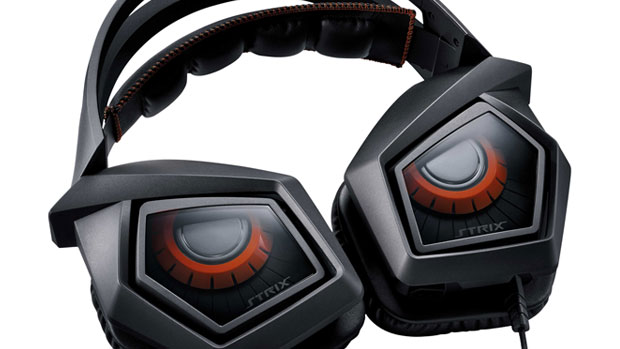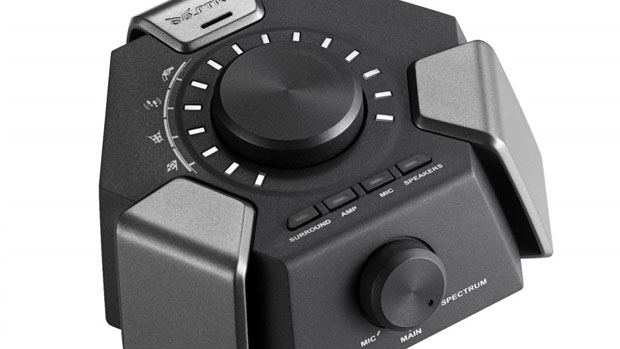It’s no surprise now that every PC hardware company is getting into gaming, from Cooler Master to Kingston to Corsair, but few brands are going at the gaming market as hard as Asus. Its Strix line-up spans a wide range, from graphics cards to input devices, but we recently had a chance to extensively test out Asus’ gaming headset – the Strix DSP.
My first impression of the Strix DSP was that it’s simply too big, a problem that’s compounded by the fact that you can’t really adjust the height of the headband like you do with most headphones. As a workaround, Asus has employed a dual-headband design, where the padded inner headband moves up and down to snugly fit over your head. That takes care of the height issue to an extent, but not really the width. To tackle that, the Strix DSP’s faux leather ear cups can be turned sideways, and the padding inside can also move in and out to accommodate different sized heads. The design tricks Asus has used will help make the headset fit more people, but not everyone. Those with small heads won’t enjoy using it, especially over longer periods.

I’m also not a fan of the headset’s design. The ear cups, when turned in, come together to form an owl’s eyes, which is a design theme Asus is carrying across its Strix range. I quite like the mix of black and orange on the headset, but the clear see-through plastic on the outside of the cups seems a bit tacky to me. That said, the construction of the headset is top notch. Everything is in plastic, but it doesn’t seem flimsy, and it all held up quite well even after over 50 hours of use.
There’s a good reason for the headset’s large size though – the massive 60mm drivers, which deliver some great sound. The ear cushions on the Strix DSP are pretty deep so the drivers are always a fair distance away from your ears, as they should be. The large drivers work in conjunction with the DSP, which is a hexagonal unit that sits on your desktop. Aside from helping enhance the audio quality, the DSP is vital as it delivers the necessary juice to power these massive drivers and make many of its features possible. Chief among these is surround sound, which is one of the most impressive aspects of the Strix DSP.
I used this headset extensively in The Witcher 3, which has so much happening aurally at all times, including the ebb and flow of the brilliant soundtrack, the rustling of trees, NPC chatter around town, and the sounds of nearby wildlife. There’s a distinct depth and direction to the way the Strix DSP delivers sound, so not only was I able to tell which direction various sounds were coming from but I could also get a better idea of how distant that sound was.

I experienced that same depth and direction in Project Cars, another game that has placed a lot of importance on sound. The roaring engines sound amazing with the Strix DSP, and once again, the sounds of opponents’ cars around me was distinct and really accurate.
The DSP has its own four presets that are designed to tailor the sound for specific types of games. The first is for shooters, the second for enhancing the sound of footsteps, the third for RPGs, and the last for racing games. Personally, I didn’t really find myself switching presets from one game type to the other because I felt the shooter preset alone did a pretty good job as a jack of all trades setting. If you also have desktop speakers, you can plug those into the DSP and switch between headset and speakers at the press of a button on the DSP without having to do it from Windows, which is a nice touch.
The DSP has two dials too. The mode switcher dial on the side dictates what function the larger dial on top performs. Setting it to Spectrum mode lets you use the top dial to choose between the above mentioned four presets; shifting it to Main turns it into a volume knob; while setting it to Mic lets you regulate the microphone’s volume.
The microphone is great and Asus has really paid a lot of attention to its design and performance. The mic comes as a separate attachment and is designed to be bent into any shape and position you desire. The DSP also has an environmental noise cancellation mic within it, which eliminates ambient sounds like your keyboard or people talking in the background, so all your friends and foes hear over the mic is your voice.
I also tried the Strix DSP to listen to music and watch movies, and while it’s a good performer across the board, it does seem to be tailor-made for game performance and that’s where it excels. The headset also works with the PS4 and mobile devices via a small adapter cable that is provided, which is a nice touch, but the DSP is only supported on PC and as a result the sound quality on other devices is nothing to write home about.
The Strix DSP is a frustrating product to review because all the great things it does in the sound department – with its quality drivers, top-notch mic and versatile DSP – are undone by its design. It’s simply too big (and kind of tacky looking) and won’t provide the ideal fit for anyone who doesn’t have a large head. If you’re in the market for a high quality PC gaming headset, the Strix DSP is right up there. Just make sure you try it on before you buy.
IVG’s Test PC:
- Processor: Intel Core i7 4790K @ 4.00 GHz
- Cooler: Cooler Master Seidon 120V Plus
- Motherboard: MSI Z97 Gaming 5
- Graphics: MSI Nvidia GeForce GTX 970 Gaming 4G
- RAM: Kingston HyperX Fury 1866 MHz – 16 GB
- OS: Windows 7 SP1
- SSD: Kingston HyperX 120 GB, Samsung 850 EVO 500 GB
- Hard Drive: Seagate Barracuda 7200 rpm 1 TB
- Case: Cooler Master N600
- Display: AOC i2769VM
- Keyboard: Ducky Shine 3
- Mouse: Logitech G400
The Asus Strix DSP is priced at Rs 7,300 in India.